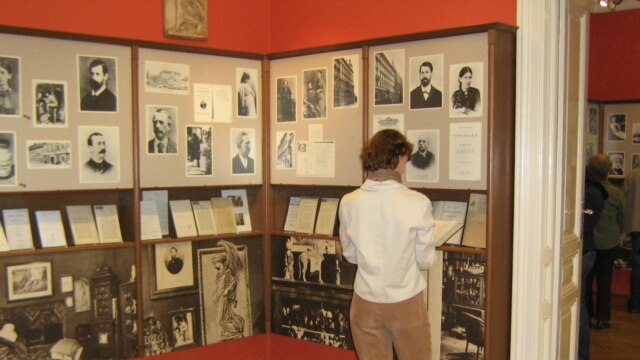Freudian slips, the Oedipus complex, repressed memories. All these concepts are thanks to Sigmund Freud and his pioneering research into the workings of the mind. May 6 marks the 150th anniversary of the birth of the founder of psychoanalysis.
Freud was born into a Jewish family in what's now the Czech Republic on May 6, 1856. But it's Vienna -- where he grew up and lived until the last year of his life -- with which he's most closely associated.
At Home With 'A Workoholic'
"In the morning, he wrote pieces and then the patients came," explains museum guide Daniela Petritz. "And then he had a meal and he worked on. He was really some kind of workaholic we would say today."
"This is his study," she says. "Here is where he worked some hours a day, he wrote the most important books in here, like "Die Traumdeutung" ["The Interpretation Of Dreams"]."
Freud began his medical career as a neurologist and soon set up a practice in his central Vienna flat to treat patients with psychological disorders.
Early on, he was intrigued by the case of a patient treated by an older colleague, Josef Breuer. There was no physical explanation for the woman's unusual symptoms -- such as paralysis in one of her arms -- but they seemed to improve when she talked freely about her feelings and the traumatic experience of her father's death.
The Talking Cure
Developing this technique further, Freud encouraged his patients to relax and say whatever came into their minds.
"When the patient came in, Sigmund Freud told him to sit down on the couch and [the patient] lay down on the couch," Petritz says. "Freud was sitting at the head of the patients, so you didn't see Freud when you were talking about your private problems and issues, so he couldn't [exert] any influence on you. This was very important for him, and the central focus was on talking therapy. This was the first time that a doctor created this kind of therapy, a psychoanalytic session where patients talked about their problems. He listened and asked [questions], but he didn't have any influence on the patients."
Freud believed many neuroses could be traced back to thoughts, events, and memories long hidden away in the mind. The key, he said, was for patients to recall them, and so understand their unconscious impulses -- particularly their sexual drives.
The Interpretation Of Dreams
Dreams became of particular interest to him. He studied some of his own, and in a long self-analysis that explored what he called his ambivalent relationship with his father.
"The dream was very vivid," Freud wrote about one childhood dream, "and showed me my beloved mother, with a peculiarly calm, sleeping countenance, carried into the room and laid on the bed by two people with birds' beaks. I awoke crying and screaming."
"He analyzed himself and his dreams in order to get new [knowledge] about dreams and the interpretation of dreams," Petritz says. "He also analyzed his and his father's life together, it was very important for him to have a biographic background to his work."
This self-study led to "The Interpretation Of Dreams" -- which was published in 1900 and is considered one of Freud's greatest works -- and to one of his most famous theories.
The Oedipus complex theorizes that boys come to see their fathers as rivals for their mothers' attention. Freud said this was one of several stages that young children go through on their way to sexual maturity.
Shocking Victorian Society
Such theories on childhood sexuality were shocking at the time, and fame and recognition came slowly to Freud.
But gradually he began to form a psychoanalytic movement, attracting high-profile adherents such as Carl Jung, and continuing to write on the hidden motivations that drive our behavior.
In 1923, after a life of heavy cigar smoking, he contracted mouth cancer and underwent many painful operations.
After the rise of the Nazis in Germany and Austria, Freud's books were burned and he was forced to flee in 1938 for Britain, where he spent the last year of his life.
In the decades following his death, many of Freud's more controversial theories have been challenged by critics as unscientific, unprovable, or simplistic. Advances in brain research made some of his ideas seem outdated. And some critics have asked whether psychoanalysis could ever really help patients at all.
But Freud inarguably had a profound and lasting influence on Western culture, and his core theory -- that much of human behavior is influenced by the unconscious -- remains a foundation of modern psychology.
Sigmund Freud
Sigmund Freud in 1938 (courtesy photo)
ON THE COUCH: A century and half after his birth, SIGMUND FREUD continues to influence cultural and scientific discourse. "There are no neutrals in the Freud wars," academic Peter Gay wrote in "Time" magazine in 1999. "Admiration, even downright adulation, on one side; skepticism, even downright disdain, on the other. This is not hyperbole.... But on one thing the contending parties agree: for good or ill, Sigmund Freud, more than any other explorer of the psyche, has shaped the mind of the 20th century. The very fierceness and persistence of his detractors are a wry tribute to the staying power of Freud's ideas."
LISTEN
Listen to an excerpt of Freud speaking in a 1938 BBC interview:
RELATED ARTICLES
Post-Soviet Russia Embraces Psychoanalysis -- Again
Freud’s Flat Shows The Man Beside The Couch
Related Links:
The Freud Museum, Vienna
The Freud Museum, London
The Sigmund Freud Archives
Freud Museum Picture Library
A Freud Bibliography
Sigmund Freud arriving in London in 1938 (AFP)



